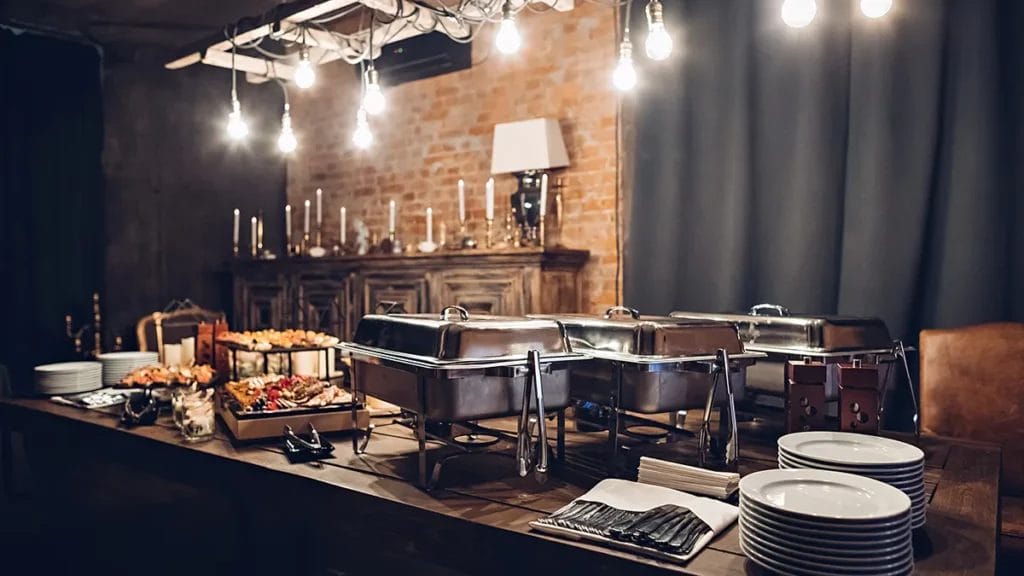Last Updated: November 15, 2024 by Alex Hastings
If you have an entrepreneurial spirit and a passion for food, starting a catering business might be right up your alley! You get to travel to various events and venues, work with a wide variety of people, and be part of making an event memorable with your delicious culinary creations.
But where exactly do you start? Get your catering business up and running with these 12 essential steps!
12 Things You Need to Do to Start a Catering Business
According to IBISWorld, there are over 97,000 catering businesses in the U.S. today. Ready to join them? Here’s what you need to do!
1. Understand the Legal Requirements
Knowing the legal requirements of your state, county, and/or city is a critical first step when starting your own catering business. Regulations and exact requirements vary depending on where you live, so check with your state’s health and agriculture departments to get accurate information.
In particular, your state’s cottage food laws will impact the way you’re able to run your catering business. Cottage food laws regulate many things regarding the sale of homemade foods, including:
- Labeling requirements
- The types of food you’re allowed to sell (perishable, non-perishable, etc.)
- The amount of revenue you can make from your home-based food business
- Whether you can sell food made in your primary residence
If you can’t prepare or cook food for your catering business from home, whether because your cottage food laws prohibit it or you simply don’t have the space and equipment necessary, renting a commercial kitchen is a great solution!
Commercial kitchens — or commissaries — allow you and other food businesses to rent their space for food prep and cooking. Unlike most home kitchens, they have industrial-grade appliances and the space you need to prepare large quantities.
Just make sure you know what commercial kitchen requirements to look out for when you’re searching for the right one to rent!
2. Conduct Market Research
Catering market research allows you to determine and define your core customer, what sets you apart from other catering businesses, and where your niche is in the existing landscape.
This process can be broken up into three parts: knowing your customer, knowing your competition, and knowing your market.
Know Your Customer
Understanding who your target customers are allows you to tailor your services, prices, and marketing strategies to resonate with them and maximize your profits.
To do this, you need to know:
- Their demographics (age, location, income, cultural background, etc.)
- The type of events they throw (weddings, corporate parties, private parties, etc.)
- Their buying behavior (one-time clients or returning clients)
- Their pain points (reliability, food quality, customizability, etc.)
Know Your Competition
By knowing your competitors inside and out, you can set your business apart from theirs and learn from their successes and failures.
When you’re researching competitors, define things like:
- Your direct competitors (other catering businesses in your area that offer the same type of services you do and have a similar target customer)
- Your indirect competitors (other catering businesses that don’t offer the same services you do, but that your customers might choose over you)
- Their strengths and weaknesses
- Their menus, services, and prices
- Their customer reviews
Know the Market
It’s important to understand the catering market as a whole, both nationally and locally, to figure out where you fit in it and how you can define success.
This involves researching:
- Seasonality (peak times throughout the year vs. slower periods)
- Consumer trends (like dietary restrictions and substitutions)
- Market size and demand
- Projected growth of the catering industry

3. Name and Register Your Business
Naming your business is one of the most enjoyable and creative parts of starting a catering service!
Try these helpful tips:
- Scope out your competitors: You probably encountered different business names while doing competitive research. Still, it never hurts to go back and make a list of the other businesses in your area so you don’t end up using a name already in use.
- Think about your goals and target customers: The name you choose should be one that resonates with your target market and reflects your business’ values.
- Incorporate search-friendly keywords: Free keyword research tools like Ubersuggest help you find words and phrases that people use when searching for businesses like yours. Including these in your business’ name can help you appear higher in search engine results.
- Use a name generator or artificial intelligence (AI): To get those creative juices flowing, it can help to use a name generator, which will give you a list of new ideas. ChatGPT can also be a huge help here because you can give it highly specific prompts to get more accurate results.
After you’ve picked a unique name you’re happy with, make sure to run it through the U.S. Patent and Trademark Office’s search system in case it has already been trademarked.
Then it’s time to register your business name! The U.S. Small Business Administration (SBA) has an awesome registration guide for you to follow, and your Secretary of State should have information on their website explaining how registration works in your specific state.
4. Secure Necessary Funding
Starting up a catering business can cost anywhere from $10,000–$50,000, depending on the size and scope of your operation. Other factors include the cost of ingredients, hiring and training staff, and equipment.
Getting the money you need to start your business can seem like a daunting task. It takes time, paperwork, and a strong business plan to secure funding. The good news is that there are several options available to help finance your dream.
Personal Savings
Small Business Administration (SBA) Loans
Private Investors
Bank Loans
Microloans
Grants
Crowdfunding
Asking for help from your community through crowdfunding platforms like Kickstarter or Indiegogo is a great way to finance your business without going into debt. Be prepared to offer rewards for donors though, such as merch or discounts on services.
Financing Your Equipment
Friends and Loved Ones
5. Develop Your Menu
Here’s the fun part — deciding what foods and services to offer!
This is where your skills and strengths come into play, as well as your target customer and your niche in the market. Your offerings should reflect all of these while also helping to set you apart from other catering businesses in your area.
Menu Categories
Catering companies typically offer things like appetizers, main courses, side dishes, desserts, and a beverage service.
A beverage service might be as simple as water, coffee, and tea, or you might consider offering alcoholic beverages too. If that’s the case, you need liquor liability insurance to protect you in the event of an alcohol-related accident.
Service Styles
Customizations
On-Site vs. Off-Site Catering
Packages

6. Set Your Prices
After creating your menu and packages, it’s time to get down to pricing. While you should be aware of what your competitors charge for their services, don’t just base your prices on theirs. They may have completely different expenses and profit margins than you do.
To determine what your prices should be, there are at least four things you’ll need to account for:
- Your food costs (the cost of ingredients per dish you serve)
- Your labor costs (wages for waitstaff, kitchen staff, bartenders, etc.)
- Service fees (what you charge for delivery, setup, and cleanup)
- Your overheads (includes fixed costs like insurance and commercial kitchen rent as well as variable costs like ingredients and supplies)
Next, decide on a profit margin. Catering businesses generally have profit margins anywhere from 7–20% — but aim for at least 10% if possible. You can always increase your margins as you become more established.
To price your catering packages, offer tiered pricing based on what is included in each package. For example, your basic package will be the most affordable whereas the premium package will come with a higher price tag.
You can also opt for per-person pricing, which can be beneficial when you cater larger events. To do this, divide your cost to cater the event (including food and labor) by the number of people in attendance to get a per-person rate.
7. Build Your Website
Every catering business needs a great website in order to be successful!
If you aren’t a web developer or don’t have the budget to hire someone to build a site for you, don’t sweat it. GoDaddy and Square Online are user-friendly site builders that make it easy for caterers to make a beautiful website, regardless of tech savviness.
No matter where you choose to build it, your website should have all of the following features:
- A domain name you purchased: Owning your own domain helps you appear professional to potential clients. Use a domain name search to find one that isn’t taken.
- A clear, easy-to-navigate menu: Clients should be able to find exactly which page they’re looking for without having to hunt for it across your site.
- Your services: Dedicate a page to the services you provide and the events you cater to.
- Menu: Include dietary information alongside each dish and include pictures when possible.
- Testimonials and reviews: Highlight comments from satisfied customers to build legitimacy and trust.
- About us page: Tell your story! Clients will feel more connected to you and your business if they know who’s behind it.
- Booking/inquiry form: Allow customers to request your services with online booking and include space for them to ask questions or provide additional information relevant to their event.
- Contact info: Create a page that has your business phone number, email address, and social media handles so clients know how they can reach you.
- Search engine optimization (SEO): Incorporating SEO-friendly keywords across your site can help your business appear higher in search engine results when people are searching for catering businesses. Use Moz’s free keyword research tool to find relevant words and phrases.
8. Acquire Necessary Equipment and Gear
Most catering businesses need a lot of equipment to operate. But the exact gear you need will vary depending on what service styles you offer.
Here’s the type of equipment and supplies you’ll need when you’re starting a catering business:
- Food preparation gear (commercial-grade cookware and appliances such as ovens, fridges, and freezers plus other smaller items like food processors and cooking utensils)
- Food storage and transportation equipment (insulated food carriers, coolers, food pans, ice chests, plastic wrap, and foil)
- Tableware and cutlery (plates, bowls, glassware, utensils, napkins, linens, and drinkware)
- Serving equipment (chafing dishes, trays, platters, serving utensils, and collapsible tables)
- Beverage service gear (water dispensers, tubs, coffee/tea urns, and portable bars)
- On-site cooking equipment (portable ovens/stoves/grills, propane burners, and generators)
- Safety and cleaning supplies (food-safe cleaning products, portable handwashing stations, gloves, hairnets, trash bags, and dishwashing equipment)
- Transportation (vehicle/truck, carts, and dollies)
- Administrative tools (point of sale system, event planning software, and inventory management software)

9. Hire and Train Your Staff
Finding the right staff for your catering business is an important part of ensuring its success. After all, your staff will play a critical role in making sure each event goes off without a hitch!
Here are some tips to start building your dream team:
- Identify which roles you need to fill: This could include servers, kitchen staff, and even supervisors depending on the size of your team. If you offer an alcohol service, you also need to hire bartenders.
- Write job descriptions for each role: Make sure they’re clear about what duties each person will be expected to perform, how many hours per week they will be working, and what skills they should bring to the table.
- Recruit your staff: Post your open roles on job boards like ZipRecruiter and Indeed or industry boards like Poached. Attend local hospitality industry job fairs to find trained professionals looking for work.
- Interview applicants: Look for people who have previous experience in the catering, food service, or hospitality industries who have excellent customer service skills.
- Train your staff: Develop standard operating procedures (SOPs) for your staff to follow and make sure they have taken and passed a food safety course like ServSafe. If you have bartenders, they must also take a state-approved alcohol safety course.
10. Protect Your Business With Insurance
Imagine getting hit with a lawsuit after catering an event because one of the guests contracted salmonella from a dish you made. They want to hold you financially responsible for this to help cover their hospital bills and recover the wages they lost while they were out sick.
This is a real catering claim one of our policyholders faced, and it nearly cost them over $70,000. However, because they had catering insurance from FLIP, we were able to cover that claim and shield them from paying out of pocket.
Starting at just $25.92 per month or $299 per year, you can get comprehensive liability insurance for your catering business and customize it with optional add-ons, including tools and equipment (inland marine), cyber liability (data breach protection) and professional liability.
Learn more about catering insurance and how you can get your free quote from FLIP today!

11. Market Your Business
Word-of-Mouth Marketing
Which is more compelling: an ad for a new local pizza joint or your best friend telling you how amazing it is and how you have to try it out?
If you picked the latter, you’re not alone. Over 90% of people say they trust recommendations from friends and loved ones over any other form of advertising. That’s why fostering word-of-mouth marketing moments for your catering business is critical to its success.
Try these tips to get people to spread the word:
- Create a referral program: If one of your clients successfully refers someone else to your catering business, reward them with a discount on a future event or a gift card to thank them.
- Encourage customer reviews: 63% of people are more likely to trust a business that has positive online reviews than one that has none. They also prefer recent reviews to older ones. Incentivize satisfied clients to leave Google reviews in exchange for discounts or a chance to win a gift card and then display those positive reviews on your website.
- Provide amazing customer service: When clients feel like you and your staff are professional, punctual, kind, and accommodating, they are more likely to recommend you to people they know. Go above and beyond expectations and reap the rewards!
Social Media Marketing
70.1% of Americans are active on social media, so using various platforms to market to them is a great way to reach them where they are.
Your catering business will benefit the most from platforms that are primarily visual where you can post pictures and videos that can showcase your dishes and event setups.
Instagram is a particularly valuable place to market your business. You can turn any post into an ad, and because it’s owned by Facebook you can connect your accounts. This makes it very easy to post simultaneously on both platforms.
Networking
Networking is an effective way for you to promote your catering business and find potential partners and clients. It allows you to form meaningful and often mutually beneficial relationships with other people and businesses in your community, opening the door to future opportunities.
Here are just a few of the ways you can network and start growing your professional connections:
- Join local business groups: Your local chamber of commerce is a great way to connect with other business owners, as are local small business associations and online forums like locale-based Facebook groups.
- Reach out to local event planners and venues: It’s smart to partner with local event organizers and venues since they can recommend you to event hosts who are looking for caterers they can trust.
- Attend industry events: Catering conferences, trade shows, and hospitality expos can be excellent places to meet others in and around the catering industry such as event planners and potential clients.
- Join wedding directories: If catering weddings sounds like your thing, join directories like Zola and The Knot. These sites are popular with couples, who often use them to find caterers in their area who do wedding services.
12. Create a Business Plan
If starting a catering business is like setting off on a journey, your business plan is your road map. Without it, the chances of getting lost or off-track are much higher.
In fact, 45% of businesses fail by their fifth year, and part of the reason for this is a lack of planning. That’s a scary number, but having a business plan you can refer back to greatly increases your chances of success.
Your business plan isn’t just for you, though — it’s also something you can show potential investors when asking for a loan.
A solid business plan should include the following sections:
- Executive summary (a brief, exciting overview of your catering business)
- Company description (a more in-depth description of your business, including your mission and goals)
- Market analysis (competitor, customer, and market research)
- Marketing strategy (how you are promoting your business)
- Loans and financing (including how much funding you still need and how you will spend it)
- Operational costs and financial projections (a detailed breakdown of your expenses and projected revenue)
- Certificate of Insurance (COI)
To make assembling your plan easier, download our catering business plan template for free!
Keep Your Catering Business Running Successfully
Starting a catering company is equal parts nerve-wracking and exciting, but by following these steps, you can set yourself up for success in this competitive industry.
Now that you know the basics of getting your business up and running, read more tips on running a successful food business and discover the secrets to thriving in the culinary world!
FAQs About Starting a Catering Business
Small catering businesses typically make between $30,000–$80,000 per year, but larger operations can easily pull in over $250,000. The largest companies make millions per year, so there is a lot of opportunity for growth and scaling your business.
- Coordination and scheduling: Timing deliveries and set-up at events requires excellent time management and punctuality from both you and your staff.
- Managing client expectations: Every client you work with will have different wants and needs, plus differing definitions of what a successful event looks like.
- Staffing shortages: Catering tends to be very seasonal, making it a challenge to make sure you’re properly staffed to meet peak demands.
- Fluctuating food costs: Global shortages and supply chain disruptions can impact the amount you pay for ingredients and unexpectedly increase your overheads.
- Make sure your staff is properly trained in food safety and handling procedures.
- Properly store food at the correct temperatures and in sealed containers to avoid contamination.
- Maintain strict cleaning and sanitization standards for surfaces, cooking equipment, and staff.
- Conduct regular quality control inspections for ingredients and supplies in case you need to find a new supplier.
- Follow manufacturer guidelines for equipment maintenance and servicing.

By Alex Hastings
Alex is a Marketing Copywriter at Food Liability Insurance Program (FLIP). In her free time, she enjoys reading, birding, traveling, and finding any excuse to get brunch.

Reviewed by: Kyle Jude
Kyle Jude is the Program Manager for Food Liability Insurance Program (FLIP). As a dedicated program manager with 10+ years of experience in the insurance industry, Kyle offers insight into different coverages for food and beverage business professionals who are looking to navigate business liability insurance.


